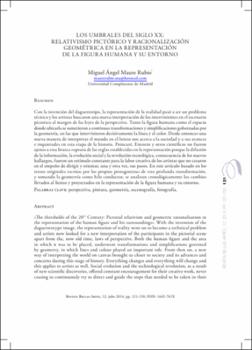Los umbrales del siglo XX: relativismo pictórico y racionalización geométrica en la representación de la figura humana y su entorno
Author
Maure Rubio, Miguel ÁngelDate
2014Abstract
Con la invención del daguerrotipo, la representación de la realidad pasó a ser un problema
técnico y los artistas buscaron una nueva interpretación de los intervinientes en el escenario
píctorico al margen de las leyes de la perspectiva. Tanto la figura humana como el espacio
donde ubicarla se sometieron a continuas transformaciones y simplificaciones gobernadas por
la geometría, en las que intervinieron decisivamente la línea y el color. Desde entonces una
nueva manera de interpretar el mundo en el lienzo nos acerca a la sociedad y a sus avances
e inquietudes en esta etapa de la historia. Poincaré, Einstein y otros científicos no fueron
ajenos a esta brusca ruptura de las reglas establecidas en la representación porque la difusión
de la información, la evolución social y la revolución tecnológica, consecuencia de los nuevos
hallazgos, fueron un estímulo constante para la labor creativa de los artistas que no cesaron
en el empeño de dirigir y orientar, una y otra vez, sus pasos. En este artículo basado en los
textos originales escritos por los propios protagonistas de esta profunda transformación,
y tomando la geometría como hilo conductor, se analizan cronológicamente los cambios
llevados al lienzo y proyectados en la representación de la figura humana y su entorno. With the invention of the
daguerreotype image, the representation of reality went on to become a technical problem
and artists now looked for a new interpretation of the participants in the pictorial scene
apart from the, now old time, laws of perspective. Both the human figure and the area
in which it was to be placed, underwent transformations and simplifications governed
by geometry, in which lines and colour played an important role. From then on, a new
way of interpreting the world on canvas brought us closer to society and its advances and
concerns during this stage of history. Everything changes and everything will change and
this applies to artists as well. Social evolution and the technological revolution, as a result
of new scientific discoveries, offered constant encouragement for their creative work, never
ceasing to continuously try to direct and guide the steps that needed to be taken in their artistic production. The new collaboration between the figure and the background, between
man and a pictorial space, progressed under the guidance of the best artists and during this
process, geometry once again provided painters with the guidelines to express their rational
and discerning thoughts.





